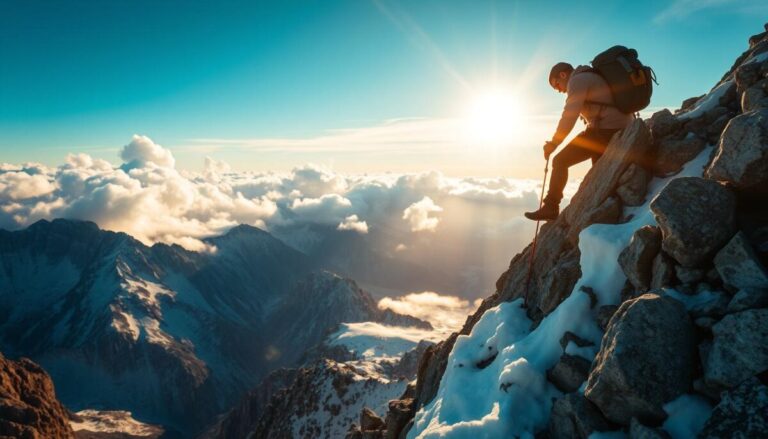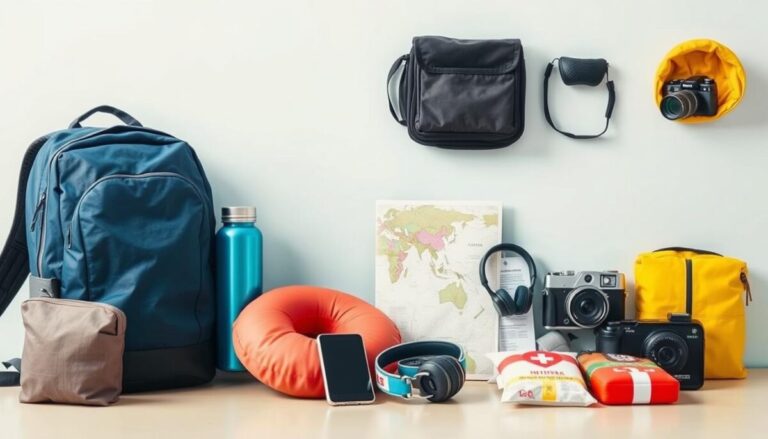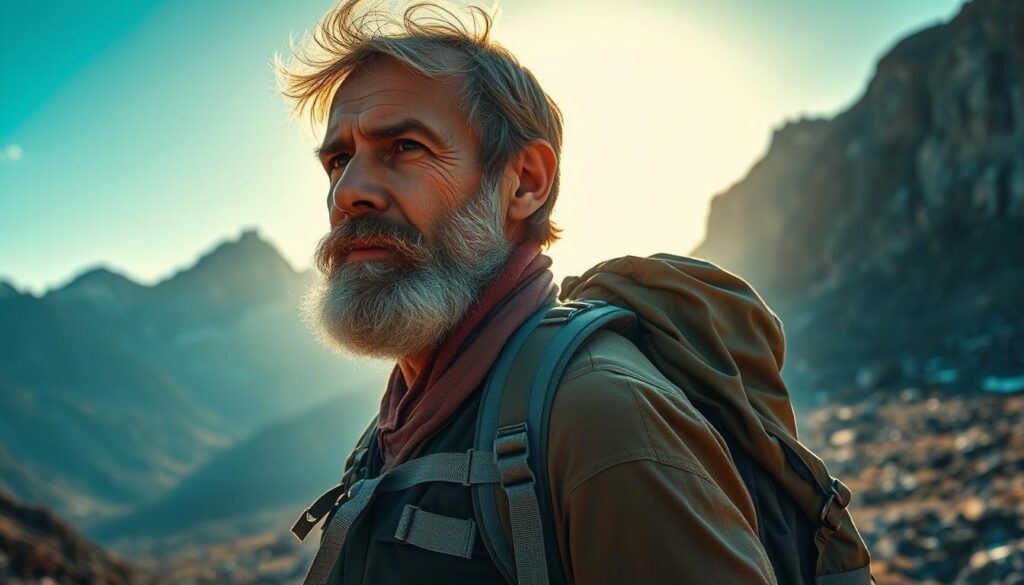
Starting a backpacking adventure can change your life. It mixes adventure, personal growth, and learning about different cultures. Before you start, it’s key to know the basics of backpacking and how to enjoy your trip.
With the right expert travel tips and a good plan, your trip will be safe and fun. This article will give you a detailed backpacking guide. It covers planning, gear, and safety, so you can enjoy the outdoors fully.
Key Takeaways
- Understand the basics of backpacking and its benefits
- Learn how to plan a successful backpacking trip
- Discover the essential gear for a safe and enjoyable journey
- Get expert tips on staying safe while backpacking
- Find out how to make the most of your backpacking adventure
Understanding Backpacking Fundamentals
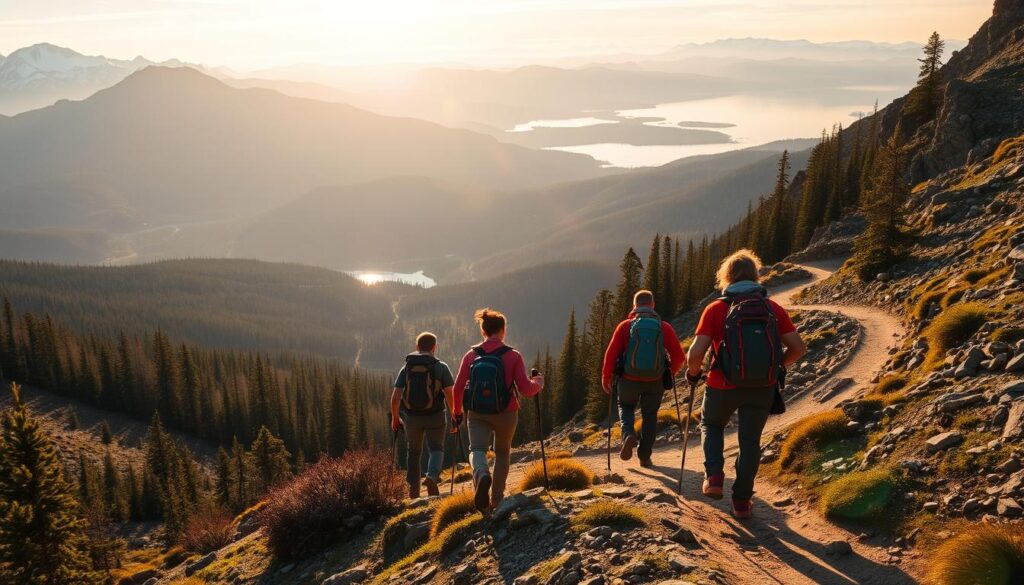
Getting ready for backpacking is all about the basics. It’s about unforgettable adventures in nature. Knowing the basics helps you enjoy the journey more.
Types of Backpacking Adventures
Backpacking trips vary a lot. You might go on a calm ultralight backpacking trip or a tough mountain trek. Knowing what you’re getting into is key.
Setting Realistic Expectations
It’s important to set realistic goals for your trip. Think about your physical condition and the terrain. This way, your trip will be fun and safe.
Physical Preparation Requirements
Being in shape is essential for backpacking. You need to do cardio and strength training. This helps you carry your pack for long distances.
Mental Preparation Strategies
Mental toughness is just as important as physical fitness. Techniques like mindfulness and positive thinking help. Start with short trips and get more confident over time.
Essential Backpacking Gear Checklist
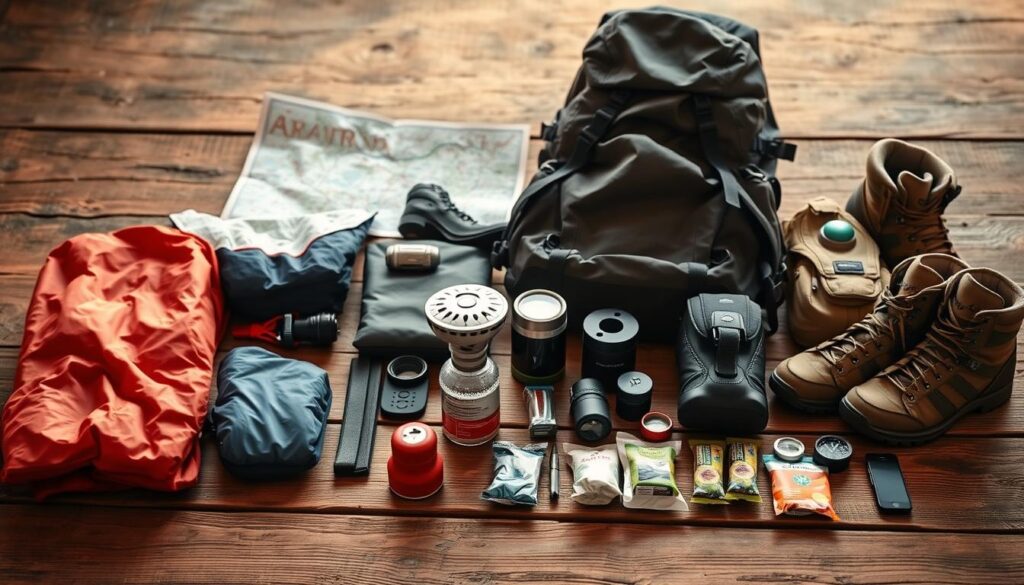
Getting ready for a backpacking trip means knowing your gear. The right equipment is key to a successful journey. It prepares you for the adventures ahead.
Backpack Selection and Fitting
Choosing the right backpack is important. Look at capacity, comfort, and durability. A good backpack fits well, spreading the weight evenly.
Key considerations for backpack selection include:
- Capacity: Pick a backpack that holds all your stuff without being too big.
- Comfort: Search for backpacks with padded straps and a hip belt for comfort.
- Durability: Go for backpacks made from strong, water-resistant materials.
Shelter Options
Shelter is a key part of your gear. You can choose from tents, hammocks, or bivy sacks. Each has its own benefits, depending on what you need.
| Shelter Type | Advantages | Disadvantages |
|---|---|---|
| Tents | Keeps you dry, has more room | Heavy, needs setup |
| Hammocks | Light, comfy, easy to set up | Needs trees, exposed to weather |
| Bivy Sacks | Light, small, easy to set up | Little room, can feel cramped |
Sleep System Components
Good sleep is vital for backpackers. Your sleep system should have a sleeping bag, pad, and maybe a liner for warmth.
Sleeping Bag Considerations:
- Insulation: Pick between down and synthetic based on the weather.
- Temperature Rating: Make sure your sleeping bag can handle the coldest nights.
Clothing Layering Systems
Layering helps control your body temperature. A typical system has a base layer, insulating layer, and waterproof jacket.
Choosing each part of your gear carefully ensures a safe and fun trip. The right gear makes a big difference in your backpacking adventure.
Nutrition and Hydration Planning
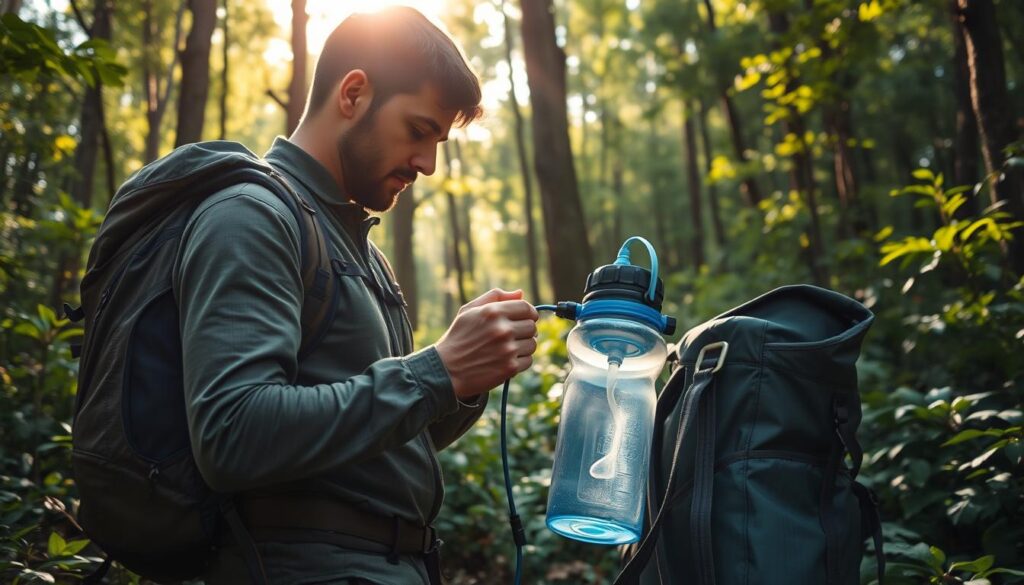
When you head into the backcountry, planning your food and water is key. Good nutrition and hydration keep your energy up and your health good. They make your backpacking trip better.
Caloric Requirements for Backpackers
Knowing how many calories you need is important. Your age, weight, how hard you hike, and the terrain affect this. Backpackers usually need 1,500 to 2,500 calories a day, but it can change a lot.
To figure out your caloric needs, think about:
- The intensity and length of your hike
- Your age and fitness level
- The weight of your backpack
- The weather
Food Storage and Preparation
Storing and preparing food right is important for a safe trip. Dehydrated meals are light and easy to cook. Keep food in airtight containers to keep it fresh and safe from wildlife.
“Dehydrated meals are a staple for many backpackers due to their lightweight and high caloric content.”
Think about how easy meals are to make and how nutritious they are. Bring a portable stove or camping grill for cooking.
Water Filtration and Treatment Methods
Having clean drinking water is a must. You can use water filters, purification tablets, or UV light. Each has its own benefits and works best in different situations.
When picking a water treatment method, think about how well it works, how easy it is to use, its weight, and cost.
Meal Planning Strategies
Good meal planning is essential for a great trip. Choose light, high-calorie foods that are simple to make. Repackage food into single servings to save weight and cut down on waste.
Some tips for meal planning include:
- Using local ingredients when you can
- Carrying out trash and leftovers
- Using a camping stove for efficient cooking
By focusing on nutrition and hydration, you can have a safe, fun, and successful backpacking trip. The right food and water make a big difference on the trail.
Navigation Skills and Tools
As a backpacker, learning to navigate is key. It can mean the difference between getting lost and finding your way. Good navigation makes your backpacking trip successful and fun.
Map and Compass Basics
Knowing how to use a map and compass is basic but important. Make sure your map is topographic and covers your backpacking area. A compass helps you match your map to the real world and find your direction.
To use a compass effectively:
- Hold the compass level and turn the bezel until the direction-of-travel arrow points towards your destination.
- Orient the compass by rotating the bezel until the magnetic needle aligns with the magnetic north indicator.
- Follow the direction-of-travel arrow to stay on course.
GPS and Digital Navigation
While maps and compasses are key, GPS and digital tools are great backups. GPS devices give exact location info and are best in bad weather.
“GPS technology has revolutionized navigation, adding safety and confidence for backpackers on the trail.”
Trail Marking and Identification
Trail marking is vital, more so when trails split. Look for signs, tree blazes, and cairns. These markers help you stay on track.
“The art of navigation is not just about reaching a destination; it’s about the journey and understanding the landscape around you.”
Getting Un-lost: Emergency Navigation
If lost, stay calm and use your tools to find your way. Without a compass or GPS, use the sun, moon, or stars to guess direction.
Key emergency navigation tips:
- Stay calm and think clearly.
- Use your last known location to estimate your current position.
- Find or create a landmark to help guide you.
Mastering these navigation skills and tools prepares you for backpacking’s challenges. You’ll enjoy a more rewarding experience on the trails.
Planning Your First Backpacking Trip
Getting ready for your first backpacking trip requires careful planning. This prep work ensures a safe and fun journey.
Destination Research
Picking the right spot is key for a great trip. Think about the terrain, distance, and how pretty it is. Look up places online and check out guidebooks and forums for tips.
Key considerations include:
- Terrain and elevation gain
- Weather patterns and possible dangers
- Rules and permits needed
- Things to see and do
Permit Requirements and Regulations
Many places you might want to go need permits or have rules. Knowing these can save you from fines or turning back.
| Destination | Permit Type | Regulations |
|---|---|---|
| National Parks | Backcountry Permit | Quota system, camping restrictions |
| Wilderness Areas | Self-registration or permit | Camping and fire restrictions |
| State Parks | Varies by park | Check with park rangers for specific rules |
Weather Considerations
Weather can really affect your trip. Look up what the weather is usually like and be ready for surprises.
Always check forecasts before heading out and be prepared to adjust your plans if necessary.
Creating a Realistic Itinerary
Make a plan based on your group’s skill and fitness level. Think about how far you’ll walk each day, any dangers, and when to rest.
A good plan should include:
- Daily hiking distances and elevation gain
- Camping spots and water availability
- Plans for bad weather or injuries
- Days off for rest
By planning well, you’ll have a safe and fun backpacking trip. Always be ready for surprises.
Backpacking Guides and Resources
Whether you’re a seasoned backpacker or just starting out, the right guides and resources are key. They can make your trip planning an unforgettable adventure. Having reliable information is essential for a successful journey.
Finding Reliable Trail Information
Start by finding reliable trail information. This means understanding the terrain, weather, and any hazards. Check official park websites, trail guides, and maps.
Organizations like the National Park Service offer detailed trail info. They cover difficulty levels and scenic spots.
Guidebooks Worth Investing In
Guidebooks are a must-have for backpackers. They offer expert tips and insights on trails and camping spots. Choose guidebooks that are updated and match your region.
Popular series include the National Park Service Guidebooks and Backpacker’s Guide to the Wilderness. They help plan your trip and enhance your adventure.
Online Communities and Forums
Join online communities and forums to connect with other backpackers. Websites like Backpacker Magazine’s Online Forum and Reddit’s r/backpacking are great places to start. You can ask questions, share plans, and learn from others.
Apps for Backpackers
Today, there are many apps to help with trip planning and navigation. Apps like AllTrails and Gaia GPS offer maps, trail info, and GPS tracking. These tools are great for staying on track and finding new trails.
Choose an app based on what you need, like offline access and weather forecasts. By using these guides and resources, you can plan a great backpacking adventure. Always research your destination well to make your trip unforgettable.
Wilderness Safety Protocols
Staying safe in the wilderness means knowing and using important safety rules. When you head into the backcountry, being ready for dangers is key for a fun and safe trip.
Wildlife Encounters and Prevention
Dealing with wildlife is a big part of wilderness safety. If you’re in bear country, keep food and trash sealed and make noise while walking. This helps avoid surprising animals.
Tips for Avoiding Wildlife Encounters:
- Make noise while hiking
- Store food and trash in airtight containers
- Avoid hiking at dawn, dusk, or night when animals are most active
First Aid Essentials for the Backcountry
A good first aid kit is essential for backpackers. It should have items for treating wounds, allergic reactions, and common injuries.
| Item | Purpose |
|---|---|
| Bandages | Wound care |
| Antiseptic wipes | Infection prevention |
| Blister care | Preventing and treating blisters |
Emergency Communication Options
Having a reliable way to communicate in emergencies is critical. You can use satellite phones, personal locator beacons (PLBs), or two-way radios.
Also, tell a trusted friend or family member your plans and carry a whistle. It’s a simple but effective way to signal for help.
Weather-Related Hazards
Weather in the wilderness can change fast, posing big risks. Learning to read weather signs and being ready for changes can help keep you safe.
Weather Preparedness Tips:
- Monitor weather forecasts before and during your trip
- Know the signs of changing weather
- Have a plan for seeking shelter or altering your itinerary if necessary
Mastering Backpacking Skills
Starting your backpacking adventure means learning key skills for safety and fun. It’s more than just carrying a heavy pack and hiking far. It’s about being ready for wilderness challenges.
Setting Up Camp Efficiently
Setting up camp right is key to a great backpacking trip. It’s about picking the best campsite, setting up your shelter, and organizing your gear. Choose a flat, well-drained spot that’s safe from the weather. Use a tarp or ground cloth to keep your tent dry.
River and Stream Crossings
Crossing rivers and streams can be scary, but you can do it safely. Always find the safest spot to cross, like a shallow area or a natural crossing. Use trekking poles or a stick for balance, and take off your boots to walk in the water.
Know the water’s depth and flow, and don’t cross if it’s too deep or fast.
Hiking Techniques for Various Terrains
When hiking on different grounds, adjust your way to stay safe and efficient. When tackling steep hills, zig-zag to reduce strain on your legs. For uneven paths, bend your knees slightly to maintain balance, and on slippery sections, rely on trekking poles for extra grip. Meanwhile, on long, flat stretches, focus on keeping a steady pace to conserve energy.
Leave No Trace Principles
Following Leave No Trace rules helps protect the environment. This means throwing away trash properly, respecting animals, and staying on trails. When camping, use a portable stove or grill instead of fires. Always take out what you bring in. These actions help keep the wilderness beautiful for others.
Environmental Ethics and Sustainability
It’s important to make sure the trails we walk on stay beautiful for future generations. When you’re getting ready for a backpacking trip, think about how your actions affect the environment.
Minimizing Your Impact
Reducing your environmental impact is key. Use reusable items, avoid plastics, and stick to the trails. These steps help keep nature untouched.
“As we venture into the unknown, heed the wisdom and guidance of those who call these enchanting lands home.” This wisdom reminds us of the importance of respecting and preserving the natural environments we visit.
Proper Waste Disposal
Properly disposing of waste is essential for the environment. Always take out what you bring in, including food waste and toilet paper.
- Use portable toilets or catholes for human waste, ensuring they are at least 200 feet away from water sources.
- Pack out toilet paper and hygiene products.
- Dispose of gray water (wastewater from washing) in a way that doesn’t harm the environment.
Respecting Wildlife and Plant Life
It’s important to respect wildlife and plants to keep ecosystems balanced.
| Action | Impact | Best Practice |
|---|---|---|
| Feeding Wildlife | Disrupts natural diet and can lead to dependency on humans. | Never feed wildlife; keep food secure. |
| Approaching Wildlife | Can cause stress and lead to aggressive behavior. | Maintain a safe distance; observe without approaching. |
| Damaging Plant Life | Can harm ecosystems and lead to erosion. | Stay on trails; avoid trampling vegetation. |
Cultural Considerations in Natural Areas
When backpacking, remember the cultural and historical value of the places you visit.
Be mindful of sacred sites and artifacts, and avoid removing items. Learning from local communities can deepen your respect and understanding.
By following these guidelines, you help protect nature and make your trip more meaningful. Remember, the journey is as important as the destination, and how you travel is a big part of the adventure.
Documenting Your Adventures
Recording your backpacking trips keeps memories alive and makes your journey even better. As you explore the outdoors, taking photos or writing about your journey lets you relive those moments. It also lets you share them with others.
Photography Tips for Backpackers
Photography is key to capturing your adventures. Here are some tips to help you take amazing photos:
- Learn how to use your camera and its settings.
- Watch for the best lighting, like during the golden hour.
- Try different angles and ways to arrange your shots.
- Choose light and tough camera gear that’s easy to carry.
With these tips, you’ll be able to capture the beauty of nature and your backpacking journey.
Journaling and Trip Reports
Journaling is a great way to document your trips. Writing about your experiences, thoughts, and feelings helps you reflect. It also keeps your memories safe for years.
When writing trip reports, include:
- The path you took and any special places you saw.
- Any challenges you faced and how you solved them.
- Encounters with wildlife or other travelers.
- Any personal achievements or milestones.
These reports are useful for planning future trips. They also let you share your experiences with others.
Gear for Capturing Memories
There’s more than just cameras and journals for capturing memories on your backpacking trips.
Think about getting:
- Action cameras for full-immersion videos.
- Portable power banks to keep your devices charged.
- Memory cards and ways to store your photos.
- Protective cases for your camera and other gear.
The right gear lets you capture your adventures without getting in the way.
Sharing Experiences Responsibly
When you share your backpacking adventures, do it responsibly. Be careful about what you post online. Also, respect the places and people you meet.
To share responsibly:
- Don’t share exact locations of places you visit.
- Respect local cultures and traditions.
- Share tips that help others backpack safely and sustainably.
- Think about how your posts might affect the environment and other travelers.
By sharing thoughtfully, you help build a positive backpacking community.
Conclusion: Embarking on Your Backpacking Journey
As you get ready for your backpacking adventure, think about exploring new cultures and meeting people. It’s about stepping out of your comfort zone. With the right prep and mindset, you’re set to face the outdoors’ challenges.
This article has given you expert travel tips and a backpacking guide. You’ll be on your way to a great trip. You’ll learn about backpacking basics and how to navigate, ensuring a safe and memorable journey.
Remember, being environmentally responsible and safe is key as you start your backpacking journey. Knowing how to backpack lets you enjoy nature’s beauty without harming it.
Now, it’s time to plan your trip and make your backpacking dreams come true. With what you’ve learned, you’re ready for an adventure of a lifetime.
FAQ
What is the best way to prepare for a backpacking trip?
What are the essential items to include in my backpacking gear checklist?
How do I plan my nutrition and hydration for a backpacking trip?
What navigation skills and tools do I need for backpacking?
How do I stay safe while backpacking?
What are the principles of Leave No Trace, and how can I apply them on my backpacking trip?
How can I document my backpacking adventures?
What are some tips for planning a successful first backpacking trip?
How can I minimize my impact on the environment while backpacking?
What are some reliable resources for backpackers?
Share :
You Might Also Like

